Payroll Audit: The Ultimate Business Guide [With Checklists 2025]
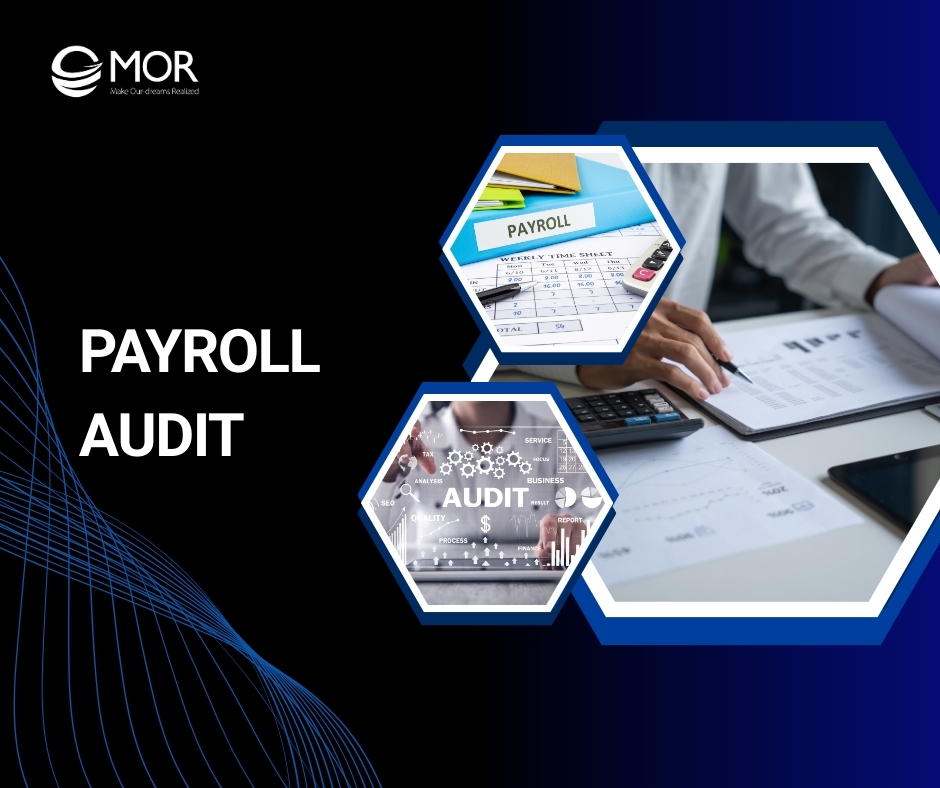
Mistakes in a payroll audit can result in heavy fines, reputational damage, and even operational disruptions. In this guide, MOR Software will walk you through proven steps and a practical payroll audit checklist to help your business stay compliant and reduce risks.
What Is A Payroll Audit?
A payroll audit is a structured examination of a company’s payroll management system that checks for accuracy, legal compliance, and the reliability of financial data. Because payroll mistakes are more common than most teams expect. Independent analysis by Ernst & Young found roughly 1 in 5 U.S. payrolls contain errors, each costing about $291 on average to resolve.
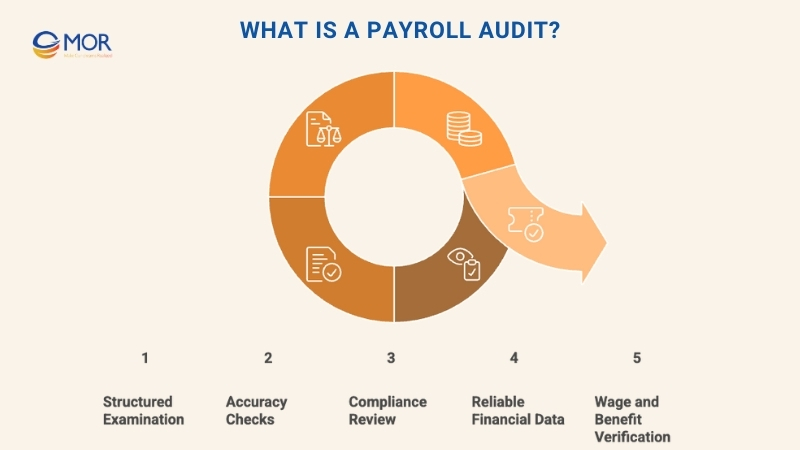
Businesses may run this review internally through their finance or HR teams, or rely on external professionals for payroll audit services. The main objective is to confirm that recorded expenses align with actual employee audit information and that wages, taxes, and benefits are processed in accordance with company rules and labor regulations.
The Consequences of a Poorly Managed Payroll Audit
In 2024, the U.S. Department of Labor recovered over $202 million in unpaid wages for nearly 152,000 workers. This highlights how payroll mistakes can quickly become expensive compliance problems. Overlooking a payroll audit or neglecting compliance requirements can expose companies to serious risks that affect both finances and operations.
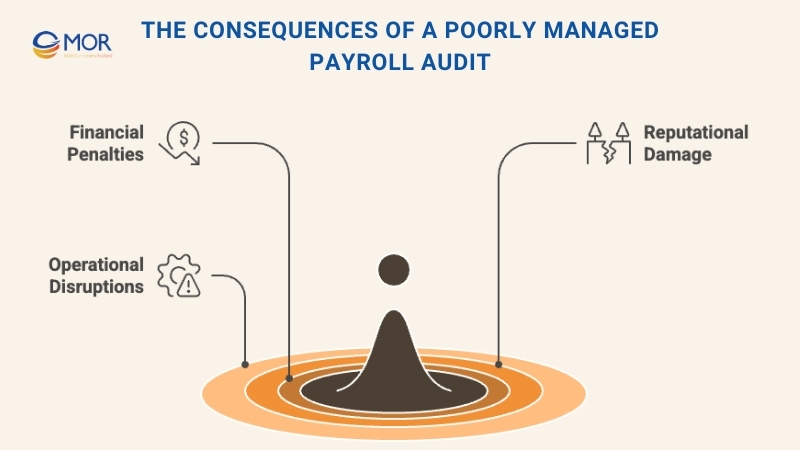
- Financial Penalties: Mistakes in reporting, tax withholdings, or employee paycheck stub misclassification may lead to costly fines and back payments. For example, the IRS “Failure to Deposit” penalty for late payroll tax deposits ranges from 2% to 15% depending on how late the deposit is, and enforcement actions regularly assess substantial totals across business accounts.
- Reputational Damage: Failed payroll audits can weaken trust among staff, while a poor track record with regulators damages long-term credibility. Research shows that nearly 1 in 4 U.S. employees (24%) would quit after just one payroll mistake, and almost half (49%) start job hunting after the second error.
- Operational Disruptions: Teams often waste valuable time scrambling to locate missing records or correct errors, which interrupts daily activities. EY’s payroll study found that a company with 1,000 employees spends the equivalent of 29 full workweeks every year just fixing payroll errors. That’s valuable time lost from core business activities.
Addressing these issues early with proper internal control for payroll turns potential setbacks into a chance to strengthen systems and create smoother payroll management.
Key Payroll Audit Objectives
The goals of a payroll audit go beyond compliance. Each objective is designed to safeguard accuracy, reduce errors, and strengthen trust in payroll operations.
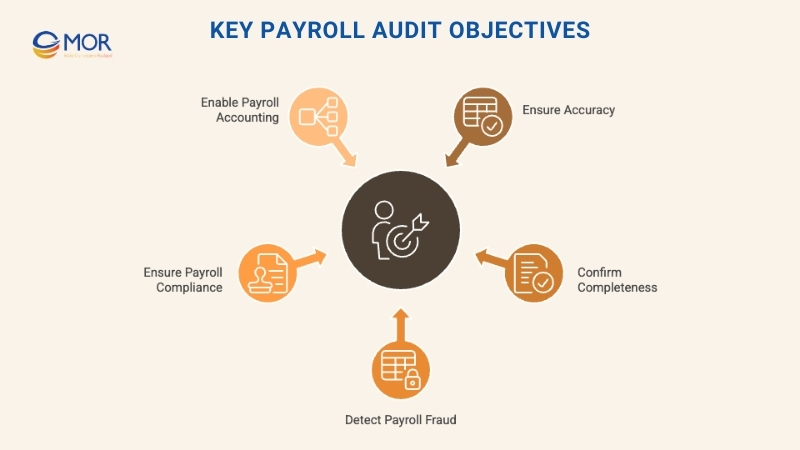
1. Ensure Accuracy
Mistakes in wage calculation often slip past payroll teams, outsourced providers, or even employees who receive incorrect pay. One of the primary goals of a payroll audit is to guarantee that every salary element is calculated with precision.
During the review, a sample set of workforce records is recalculated to confirm consistency. In addition, formulas and rules built into the payroll system are analyzed. To secure reliable outcomes, approval chains and the supporting records that drive calculations are verified. This process forms part of payroll internal controls best practices, helping organizations avoid recurring errors and strengthen confidence in their payroll function.
2. Confirm Completeness
Another important objective of auditing payroll is confirming that every salary and benefit has been processed for all employees and paid on schedule.
This covers routine salary for full-time, part-time, and contract staff, along with off-cycle items like reimbursements, insurance payments, termination settlements, or employee loans. Any pending amounts are flagged and explained in the final report, ensuring the payslip run is complete and accurate.
3. Detect Payroll Fraud
Fraudulent activity in payroll can affect businesses regardless of size, and it often goes unnoticed if controls are weak. Both internal staff and outsourced vendors may be involved, which makes fraudulent transactions harder to detect compared to accidental payroll mistakes.
A central aim of the payroll audit is to confirm occurrence and existence. Auditors verify that the payments recorded in the payroll system have actually been made, and only to legitimate employees of the organization. Through this step, companies can reduce payroll risks and protect themselves from potential financial losses tied to fraud.
4. Ensure Payroll Compliance
Another core objective of audit payroll activities is meeting tax and labor compliance requirements. During this process, tax withholdings are examined to confirm that payments were submitted to government authorities on time.
Auditors also confirm whether contributions to programs such as provident funds and pension schemes have been handled correctly. On top of that, checks cover approvals, payslip distribution, and recordkeeping, ensuring that the payroll process follows every mandatory regulation.
5. Enable Appropriate Payroll Accounting
Payroll costs form a major component of the Profit and Loss (P&L) statements that companies share with investors and tax agencies.
During a payroll audit, auditors check that payroll data is presented fairly and without distortion. Any unresolved balances are documented in the payroll checklist, with explanations and recommendations for corrective steps.
Benefits of Running a Payroll Audit
Beyond meeting compliance requirements, a payroll audit delivers practical advantages that directly improve business performance.
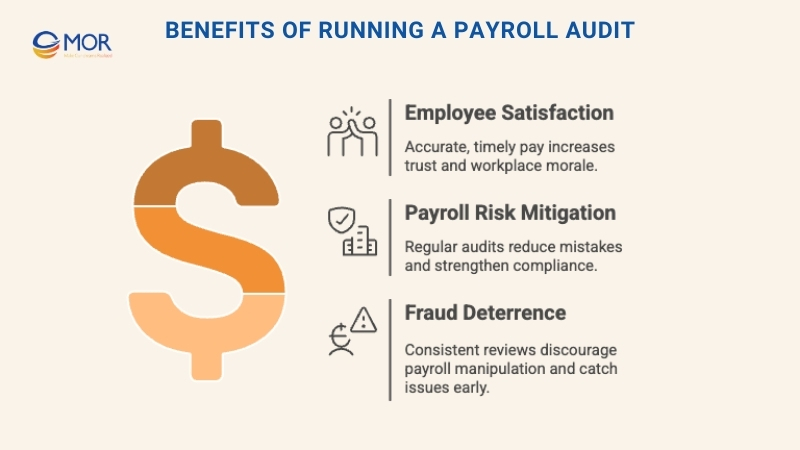
1. Improved Employee Satisfaction
Payroll is a critical part of the overall value proposition employees receive from their workplace. When payments are late or inaccurate, frustration quickly builds. In fact, research shows that nearly half of professionals consider changing jobs after facing only two payroll errors.
Employees want timely, error-free salary payments and accurate tax documentation for filing returns. Through payroll audit support, companies can verify that salaries, payroll deductions, and tax forms are correct. This strengthens trust, enhances retention, and increases employee satisfaction across the workforce.
2. Payroll Risk Mitigation
Carrying out a payroll audit on a regular basis helps businesses spot areas where payroll processes and systems can be improved. This includes keeping employee records updated and making sure the latest tax regulations are correctly built into the payroll application.
It also verifies that payroll data is stored securely for the legally required duration. These measures lower the chance of mistakes or compliance breaches, providing stronger safeguards against common payroll risks over time.
3. Fraud Deterrence
Conducting a payroll audit on a consistent basis, along with strict consequences for fraudulent behavior, acts as a strong deterrent against payroll manipulation. These audits also reveal warning signs and enable the setup of smart alerts within payroll systems to flag unusual activities early.
According to global research, internal reviews and document checks uncover nearly a third of workplace fraud cases. In many regions, external audits of financial records remain the most widely used safeguard, with a vast majority of companies relying on them to strengthen payroll audit checklist practices.
How to Conduct a Payroll Audit
Once the importance of auditing payroll is clear, the next step is learning how to execute it in practice. The process below outlines a structured approach that organizations can follow.
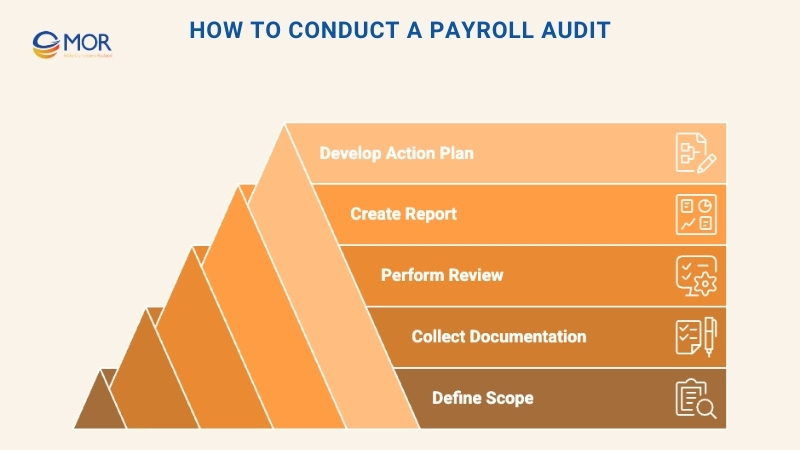
1. Define the Scope and Objectives
Kimberly DeCarrera, Fractional CFO at Springboard Legal, explains that the first step in a payroll audit is identifying the goal. Common purposes include retirement plan compliance, workers’ compensation checks, equal employment requirements, or even preparing for lawsuits. Starting with a clear objective ensures the right data is gathered and examined.
Pro Tip
Seann Malloy, Founder and Managing Partner of Malloy Law Offices, recommends documenting the audit process thoroughly. Findings may serve as evidence in legal or regulatory actions. He advises involving counsel early to maintain attorney-client privilege, comply with record retention rules, and understand when audit discoveries might trigger mandatory reporting duties. These precautions strengthen the reliability of the entire payroll audit services exercise.
2. Collect Payroll Documentation
The next step in a payroll audit is gathering every record relevant to the review period. These include:
- Employee files with hire dates, classifications, and wage rates
- Attendance and timekeeping logs
- Paystub vs payslip and payroll system reports
- Tax filings such as W-2s, 1099s, 941s, and 940s
- Direct deposit instructions
- Records of benefits and deductions
Lee Baldwin, Head of Managed Services at Pay Check Limited, notes that accuracy in employee data is critical:
“When auditing payroll, the first priority is to make sure employee records are consistent across HR and payroll systems. That means checking status, titles, pay rates, scheduled hours, and tax details. For example, I compare W-4 forms with the tax withholdings in the system. If dependents or marital status change but records aren’t updated, withholdings may be wrong, and penalties from the IRS can follow.”
Tip: Along with core records, keep system logs or audit trails of manual adjustments. This helps validate unusual entries and strengthens the payroll audit checklist.
3. Perform the Payroll Audit Review
With documentation in place, the next step is to carry out the actual payroll audit. This review covers several focus areas that highlight potential compliance gaps or errors.
Employee Classification
- What to check: Verify employees are properly categorized as exempt or non-exempt under FLSA rules, and as employees versus independent contractors.
- Why it matters: Incorrect classification can result in penalties, unpaid wages, and serious tax issues.
Wage and Hour Compliance
- Hours Worked: Match reported hours against pay received.
- Overtime: Confirm overtime is calculated correctly for non-exempt employees.
- Minimum Wage: Validate rates against federal, state, and local wage laws.
Deductions and Benefits
- Authorized Deductions: Make sure all deductions, from garnishments to benefit costs, are properly documented and legally allowed.
- Benefit Contributions: Check that employer and employee contributions to health insurance, retirement, and other plans are correct and timely.
Tax Withholdings and Reporting
- Federal, State, and Local Taxes: Confirm withholdings are accurate and deposits are submitted on schedule.
- FICA and FUTA/SUTA: Ensure calculations for Social Security, Medicare, and unemployment taxes are correct.
- Tax Filings: Compare W-2s, 1099s, and quarterly tax returns against internal payroll records.
Pay Frequency and Accuracy
- Pay Periods: Validate that payroll runs follow the published company schedule.
- Gross-to-Net Calculations: Recalculate a sample of payslips to check for accuracy.
Leave and PTO Tracking
- Accrual Accuracy: Ensure leave balances, vacation, and sick accruals are tracked according to company policy and legal standards.
- Usage Recording: Confirm that leave used has been properly deducted and reflected in payroll.
Review Payroll Policies and Procedures
Audit company payroll policies to ensure they are updated and compliant with labor regulations. Strong payroll internal controls best practices reduce the chance of oversight when managing these obligations.
4. Create a Payroll Audit Report
Once the review is complete, the next step in a payroll audit is compiling a clear summary report. While the format may differ by payroll outsourcing companies, a typical report includes the following elements:
- Title Page
- Report title: Payroll Audit Report
- Company name
- Audit period (e.g., Jan 1 – Mar 31, 2025)
- Date of report
- Auditor’s name and position
- Executive Summary
- A one-page overview covering the audit’s purpose, scope, and methodology
- Key findings, such as discrepancies or misclassification issues
- High-level recommendations for next steps
- Scope and Objectives
- Define what was reviewed (for example, payroll data from multiple departments or systems)
- Objectives such as ensuring compliance, confirming accuracy of payments, and reviewing classifications
- Methodology
- Specify the types of records analyzed, from payroll files to HR system integration data and tax forms
- Detail the sampling approach and tools used to evaluate accuracy
- Detailed Findings
- Break down results by category: employee classification, wage and hour compliance, deductions, taxes
- Note each issue, its impact, the root cause, and a proposed resolution
- Recommendations
- Provide actionable improvements such as automating overtime checks or updating classification reviews
- Assign priorities (Critical, High, Medium, Low) to guide decision-making
- Appendices: Attach supporting documents like payslips reviewed, recalculations, screenshots, or policy references
Well-documented reports not only improve clarity but also strengthen the credibility of the payroll audit checklist for management and regulators.
Presentation Tips:
- Know your audience
- Executives: Focus on risks, compliance gaps, costs, and strategic improvements
- HR/Payroll Teams: Point out process flaws, system tools, and tactical changes
- Finance: Stress financial implications and weaknesses in internal control for payroll
- Use visual aids
- Charts to show errors by type or department
- Tables summarizing findings with severity levels
- Diagrams mapping process gaps or workflow breakdowns
5. Develop an Action Plan
Once discrepancies and improvement areas are identified during the payroll audit, the next step is to build a structured action plan to resolve issues and strengthen ongoing processes.
The objective is to fix problems, improve compliance, and enhance payroll efficiency over the long term. To achieve this, group audit findings into themes such as employee classification, tax compliance, wage calculations, and benefits administration.
Each issue should be prioritized according to risk level or business impact. Urgent concerns, like potential legal exposure or financial liabilities, must be handled first. For every category, set clear objectives and convert them into specific, trackable tasks.
Examples include reclassifying contractors, automating overtime calculations, or scheduling routine reconciliations of benefit deductions. Each action should have:
- A designated owner
- Target completion dates
- Status updates
- Tools, approvals, or payroll audit support as required
Capture this information in a centralized tracker, whether a spreadsheet or project management platform, so progress is visible and measurable. Regular check-ins, such as biweekly reviews, keep accountability high and ensure the plan remains on track.
As fixes are rolled out, update related documents, standard operating procedures, payroll manuals, and employee handbooks, to reflect new practices. Where possible, embed preventive measures like approval workflows or automated audit checks to avoid repeated errors.
Finally, scheduling a follow-up payroll audit helps confirm the improvements are working and reinforces long-term compliance.
HR Payroll Audit Checklist
An HR payroll audit checklist gives structure to the review process. We provide this checklist for you to follow step by step, making sure every payroll review is accurate, compliant, and easy to manage.
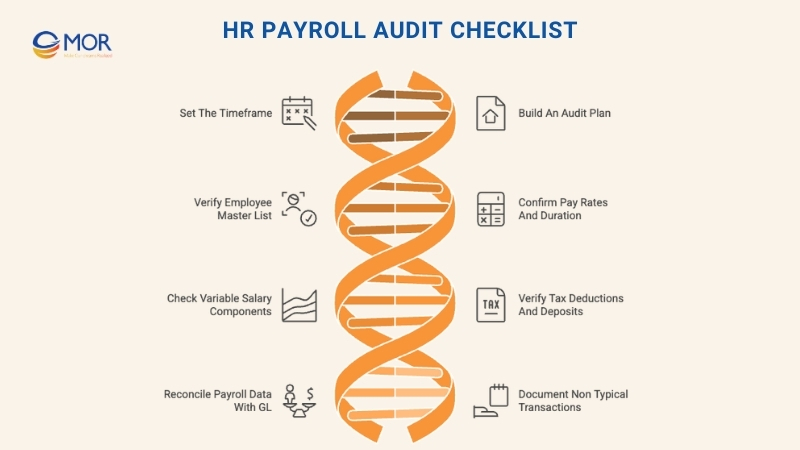
1. Set the Timeframe for the Audit
The first step in any payroll audit is to decide the timeframe for reviewing payroll data.
Most organizations schedule an external audit once a year, covering the full financial year. Internal audits, however, can be performed more frequently, quarterly or semi-annually, depending on team capacity and the maturity of payroll operations. Setting this period in advance ensures the review is consistent and comprehensive.
2. Build an Audit Plan
An effective payroll audit checklist requires a clear plan outlining which teams will be involved. Typically, this includes human resource development, payroll, finance, IT, and any external vendors supporting payroll processing.
The plan should also specify the payroll reports and documents to be reviewed, making sure they are collected and accessible before the audit begins. Additionally, it must detail the processes and payroll applications to be examined for compliance. Finally, define the sampling approach so that the records selected provide an accurate view of performance, compliance, and potential gaps in payroll internal controls best practices.
3. Verify Employee Master List
An important step in any payroll audit is confirming the accuracy of the employee master list for the period under review. This record should include details such as employee IDs, full names, job titles, salary account information, start dates, tax categories, and end dates for those no longer employed.
The list must remain consistent across HR, payroll, and accounting systems to ensure only eligible staff receive payments. Auditors also verify that every individual is categorized correctly under tax regulations. For example, as a contractor, part-time worker, or full-time employee. Keeping this list synchronized strengthens compliance and reduces errors during processing.
4. Confirm Pay Rates and Duration Worked
Another key activity in audit payroll reviews is checking that employee pay rates are applied correctly in payroll calculations. For salaried staff, the current compensation structure should be reflected in payroll records. For contractors or hourly workers, the agreed rates in their contracts must be used to validate gross pay.
The actual hours or days worked are then cross-checked against attendance systems, timekeeping logs, or leave management software. This ensures that gross pay is accurate, transparent, and consistent with documented work records, reducing the chance of disputes or miscalculations.
5. Check Variable and Non-Regular Salary Components
As part of a payroll audit, auditors need to verify variable and irregular salary elements to confirm they are processed correctly. This involves reviewing reports from performance management systems to ensure performance-linked pay matches the approved data.
Full and final settlements for employees who exited during the audit period must also be checked. These settlements should include gratuity, leave encashment, and other entitlements. In addition, overtime payments for eligible staff should be reviewed to confirm they align with policies and legal requirements. Addressing these areas prevents errors that can create disputes or compliance issues.
6. Verify Tax Deductions and Deposits
The audit should also confirm that all tax deductions have been calculated accurately. This means verifying that TDS has been applied on each salary component in line with income tax laws. Investment proofs, rent receipts, and loan certificates provided by employees must be reviewed to ensure exemptions are valid.
It is equally important to verify that the correct tax rates were applied during net pay calculations. Finally, receipts for deposits should be cross-checked to confirm that TDS and professional tax amounts were remitted to authorities on time, reducing exposure to payroll risks.
7. Reconcile Payroll Data with General Ledger (GL) Reports and Bank Statements
During a payroll audit, reconciliation is a vital step. The General Ledger (GL) captures every company transaction under specific accounts, and salary disbursements must align with the amounts recorded in payroll expense accounts.
In addition, liabilities such as contributions to social security or insurance schemes should match figures in the GL payable accounts. The reconciliation process must also compare payroll payout records against actual bank statements. This ensures the amounts transferred to employees match the records, and that bank details correspond to those listed in the employee master file.
8. Document Observations on Non-Typical Transactions
The audit must capture, analyze, and explain any transaction that falls outside routine payroll cycles. This includes off-cycle adjustments such as retroactive pay, underpayment or overpayment corrections, and one-time bonuses or rewards.
Each of these entries should be noted in the report with supporting details, along with recommended actions for follow-up. Thorough documentation not only strengthens compliance but also enhances the reliability of the payroll audit checklist, making future reviews faster and more effective.
Common Payroll Audit Mistakes
Recognizing frequent mistakes during a payroll audit helps organizations address issues before they escalate. Some of the most common errors include:
- Timecard discrepancies: Inaccurate or incomplete timecards raise immediate red flags. Always ensure records are complete and reflect actual job details.
- Missing or incomplete payroll records: Gaps in documentation can slow down the audit process. Maintain organized and accessible records at all times.
- Subcontractor issues: Verify that subcontractors meet certified payroll obligations and submit all required documentation.
- Math errors: Recheck wage rates, overtime calculations, and benefit contributions for accuracy.
- Record retention: Keep payroll records for the legally mandated period to prevent penalties.
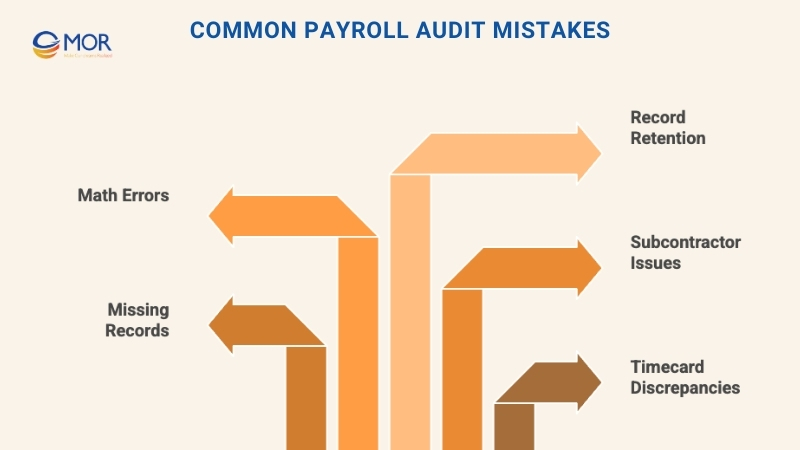
Avoiding these mistakes strengthens compliance and streamlines auditing payroll processes for future cycles.
How Payroll Software Supports Employers In Payroll Audit
Modern payroll software plays a crucial role in simplifying the payroll audit process. By automating tasks, ensuring accuracy, and providing complete visibility into payroll records, these tools make audits faster and more reliable.
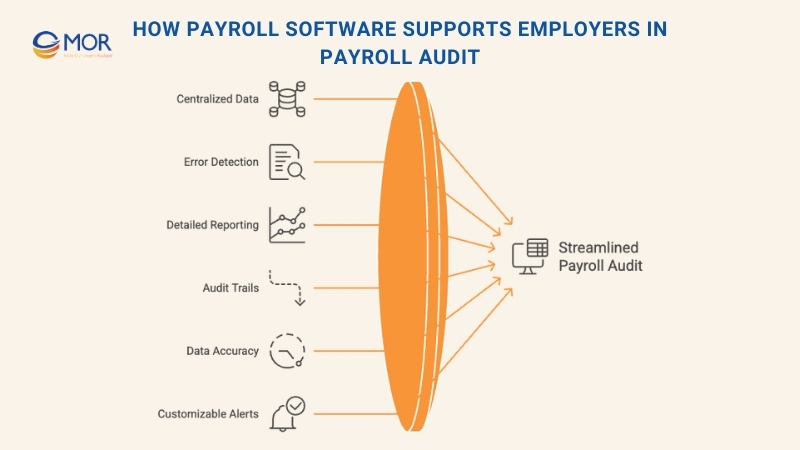
Here are some of the key benefits payroll software brings to an audit:
- Centralized data: Payroll records are stored in one system, making them easy to review during audits.
- Error detection: Automated checks highlight irregularities or suspicious activity.
- Detailed reporting: Generate comprehensive reports on payroll transactions, tax filings, and employee earnings.
- Audit trails: Every change is logged with details of who made it and when, ensuring activities can be verified.
- Data accuracy: Validation and consistent calculations minimize mistakes across payroll cycles.
- Customizable alerts and checklists: Build audit reminders that align with company needs, ensuring critical steps are never missed.
- Historical data access: Retrieve past records for comparisons, trend analysis, or anomaly detection.
- Backup and recovery: Regular backups secure payroll data and guarantee recovery in case of system failures.
At MOR Software, we provide smart HRM software development solutions that streamline every stage of the audit. Our platforms centralize payroll data, generate detailed reports, and maintain secure audit trails, enabling HR and finance teams to detect discrepancies quickly. With automated alerts, tailored checklists, and strong employee audit capabilities, businesses can maintain compliance, transparency, and control over payroll processes.
Conclusion
A well-structured payroll audit not only ensures compliance but also strengthens accuracy, prevents fraud, and protects employee trust. By following the right steps and using technology, businesses can turn payroll reviews into a driver of efficiency. At MOR Software, we deliver payroll solutions that simplify every stage of the process. Ready to improve compliance and minimize risks? Contact us today to discuss how we can support your business.
MOR SOFTWARE
Frequently Asked Questions (FAQs)
What is a payroll audit?
A payroll audit is a structured review of a company’s payroll records, systems, and processes. It compares payroll data with compliance requirements and organizational policies to confirm that wages, taxes, and deductions are accurate and properly documented.
What is the meaning of payroll audit?
It refers to the process of carefully checking payroll information for accuracy. Employers review pay rates, working hours, tax withholdings, and other details to ensure employees are paid correctly. The time needed for this review depends on the scope of the audit and the size of the organization.
How do you audit payroll?
To run a payroll audit, employers typically:
- Review employee records.
- Verify hours worked and payments issued.
- Examine overtime, bonuses, and variable pay.
- Document unusual payroll transactions.
- Confirm tax withholdings and timely deposits.
- Reconcile payroll with accounting records.
- Check payroll compliance with internal rules.
- Summarize and report the findings.
What are the issues with payroll audit?
Common issues include misclassifying employees, applying outdated or incorrect pay rates, inaccurate overtime calculations, or missed payments. Such mistakes can result in overpayments, underpayments, or compliance penalties.
What is a payroll compliance audit?
A payroll compliance audit, sometimes called employer compliance reporting, checks whether an organization is making the correct contributions to employee benefit plans. It ensures the company is following collective bargaining agreements, participation agreements, or other binding commitments.
What are the objectives of payroll audit control?
The main goals are to verify that employees receive the correct pay, that calculations are accurate, and that every payroll transaction is properly recorded. It also ensures payroll deductions are remitted to the appropriate authorities or third parties.
How often do companies audit payroll?
Most organizations conduct at least one payroll audit per year. However, many prefer to perform audits twice yearly or quarterly to catch errors early and reduce compliance risks.
What are the types of auditing?
Audits are generally divided into two categories:
- Internal audit, which is carried out by the organization’s own team.
- External audit, which is done by an independent third party for objectivity.
What are the assertions related to payroll audit?
Key audit assertions for payroll include:
- Accuracy: Payroll transactions must be recorded without error.
- Cut-off: Payroll entries must be recorded in the correct accounting period.
Rate this article
0
over 5.0 based on 0 reviews
Your rating on this news:
Name
*Email
*Write your comment
*Send your comment
1